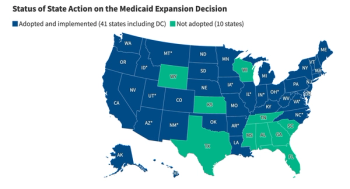
HHS wants to ratchet down premium hikes
Insurers see higher unit costs and increased utilization while HHS examines premium hikes
The good news in January from the Office of the Actuary at the Centers for Medicare and Medicaid Services (CMS) is that U.S. health expenditures remained flat for 2011, rising 3.9% to $2.7 trillion in annual health outlays. That growth still exceeds current inflation rates, and it’s low largely because of lingering effects of the recession.
Health and Human Services (HHS) secretary Kathleen Sebelius credits provisions in the Patient Protection and Affordable Care Act (PPACA) for limiting outlays, pointing to its success in holding down private health insurance premiums, which rose only 3.8% in 2011. Analysts note impact from PPACA’s medical loss ratio provision and required coverage of dependents under age 26 boosted enrollment in private plans by 1 million-largely young, healthy individuals that helped maintain low per-person expenditures.
The broader impact of PPACA expenditures and savings won’t be apparent until next year. Another CMS study predicts that in 2014, healthcare spending will surge by 7.4% as millions gain coverage. Consumers already face higher out-of-pocket costs as employers seek to limit healthcare spending, a factor boosting worker enrollment in consumer-directed health plans, up from 8% in 2008 to 17% in 2011.
Premiumsandcosts
In anticipation of these changes, insurers are seeking higher premiums on individual and small group policies for 2013, generating complaints from Sebelius and state regulators. Insurers complain that higher medical costs and a new $8 billion PPACA fee are driving up the cost of coverage. The authorities challenge moves to boost premiums this year to cover anticipated costs for 2014.
Recently, a rate request from Blue Cross of California was opposed because it was unreasonable to charge customers for fees not due for a year. Aetna, UnitedHealth and others have proposed similar double-digit increases for individual and small market coverage, partly to avoid bigger rate spikes next year.
Insurers seek to explain their actions with data highlighting cost factors underlying rising premiums. An Oliver Wyman study funded by America’s Health Insurance Plans (AHIP) examines how PPACA age rating restrictions will boost premiums for young adults, especially those that don’t qualify for premium assistance.
Such research will help insurers influence the upcoming debate on healthcare cost cutting, which will build on the tax relief act approved by Congress January 1 to postpone major budget cuts and tax hikes. That legislation delayed a 26.5% reduction in Medicare rates for doctors, covering some of the $25 billion cost through “adjustments” in Medicare pay to hospitals, more intense review of coding by Medicare Advantage plans and other program revisions.
The need for further budget cuts could build support for more Medicare means testing, a higher eligibility age, curbs on Medi-gap first-dollar coverage and tighter rates for MA plans.
There is no shortage in cost-cutting proposals. UnitedHealth Group predicts big savings from better coordination of care for patients with chronic diseases. The Kaiser Family Foundation recently unveiled a list of 150 policy options with potential for reducing Medicare spending. Like healthcare interest groups, insurers are looking for cuts to protect their funding streams.
Newsletter
Get the latest industry news, event updates, and more from Managed healthcare Executive.





















































